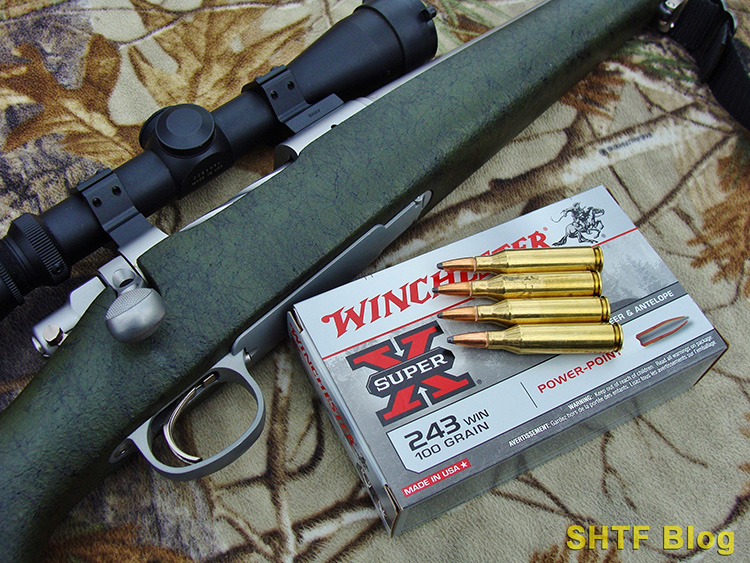
As I write this it’s deer season and, typical of our area, hunting stories abound. Some end well but others, not so much. Inevitably, there’s bound to be a debate around the best ammo for deer.
One story I just heard about arrived by e-mail from a trusted friend. Here’s his account:
I still have two tags left. I’ve been out a few times since I took a doe but the majority of one of those days were spent recovering a deer that a friend’s wife shot. She used an SMK round (which I have counseled against). She hit a small buck which started walking away, so she shot him again.
Each time it was assumed the deer was lying down to bleed out, but he would get up and run off when approached. I went down to a nearby stream to see if I could find a blood trail and lo and behold, there he was. We waited about 30 minutes and walked up on the deer, deceased.
More about this story. The rifle was a .308 Winchester. The load was a Federal Premium version, topped with a 168-grain Sierra Match King BTHP (boat-tail hollow-point). This bullet is known for its exceptional accuracy. It also resembles some hunting bullets, including a favorite of mine. But, that’s not what the SMK is made for. It’s real forte is precision shooting. That’s why Sierra sells their GameKing version, a well-proven hunting choice.
Meanwhile, during the same time period, a fat four-pointer trotted by my stand. Seizing a fleeting opportunity, I capitalized on an opening between two trees. The shot felt good but the deer bolted as if unhit, disappearing into thick cover. Having been this route before, I just sat tight and gave it time. Turned out the deer was piled up from a heart shot, only a few yards beyond where I’d last seen him.
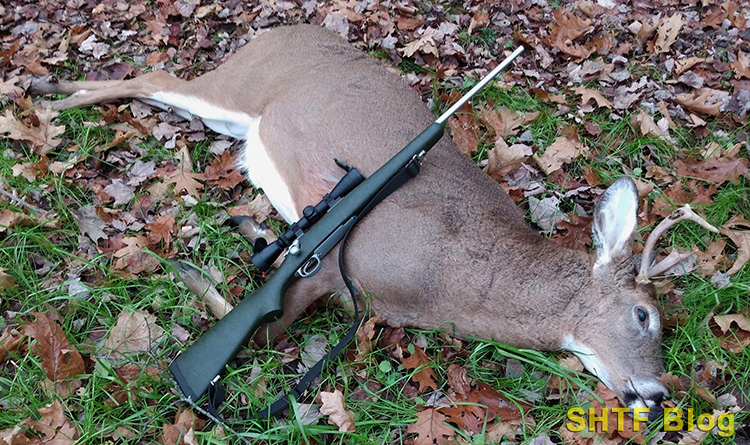
The bullet was a plain-vanilla .243 soft-point; Winchester’s 100-grain Super-X Power-Point. This load, combined with a Remington Model Seven bolt-action, has accounted for six deer in as many years; all one-shot kills with similar outcomes. Each resulted in a 40-yard dash, along with minimal meat loss and a freezer full of venison. It’s advertised at 2960 feet-per-second (fps), but clocks 2750 fps from my 20-inch barrel – not necessarily a bad thing.
All of these deer were shot inside 100 yards so, just maybe, the throttled back speed helped prevent over-expansion upon contact with bone. It’s worth noting most were smaller bucks by Maine standards. So far, none of the six have topped 165 pounds, field dressed. Nevertheless, I seldom find an exit (an exception being the above deer). Then again, the .24-caliber projectile is small and relatively light. It’s also not a so-called “premium” bullet.
The several boxes I bought on sale at Walmart (back when ammo pricing was sane and ammo deals plentiful) cost around $16 per box – probably less than half that of a premium version.
Actually, I prefer a pass-through. If nothing else, two holes help for tracking – a big help since I struggle to see red. Thus, I purchased a set of .243 Winchester reloading dies and a few boxes of a favorite premium bullet; Barnes solid-copper Triple Shocks (TS-X).
Being lighter than lead, the weight of this TS-X is only 85-grains. However, thanks to experience with the TS-X in other calibers, I was well aware of its attributes; reliable expansion, deep penetration, and excellent accuracy.
So, why even bother with the basic WW .243 Super-X load? Well, although we’re rural, a couple of houses pose enough of a concern that less penetration seems safer.
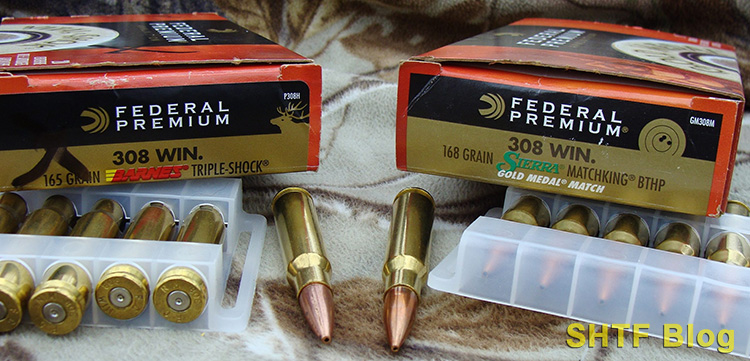
Premium Bullets for Deer?
In bigger woods with prospects of whopper bucks, I’ll go with a larger caliber. And, depending on the circumstances, it could be topped by a “premium” bullet.
Monolithic Bullets
The four members of my hunting circle have taken a number of deer with Barnes solid-copper TS-X bullets in .300 Blackout (TAC-TX version), .308 Winchester, .300 Remington Short-Action Ultra-Mag (SAUM), .338 Federal, .350 Remington Magnum – and, probably, a couple other calibers.
To date, I only have three recovered bullets, all of which penetrated deer lengthwise until stopping in their hind-quarters. All exhibit text-book expansion and near-one hundred-per-cent weight retention.
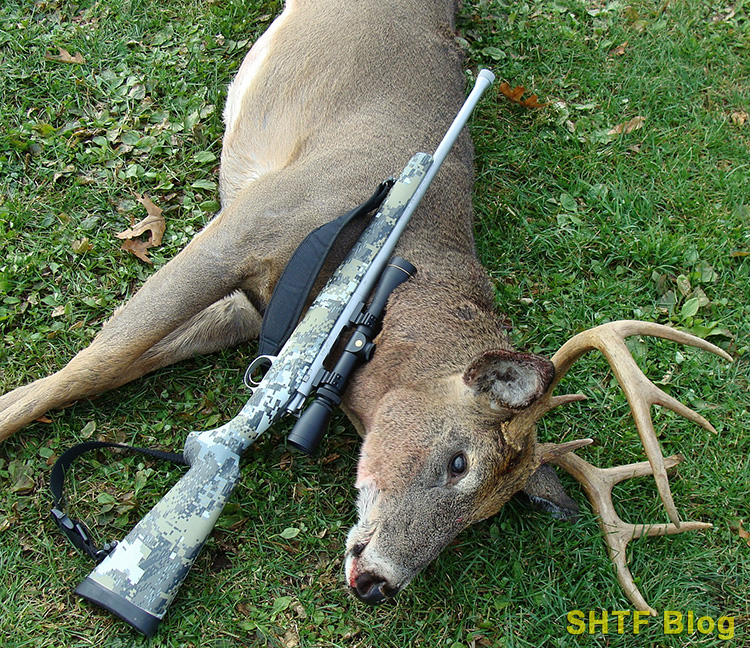
I started using 150-grain TS-X bullets (as handloads) after acquiring a .300 SAUM Model Seven and the reason was somewhat unique. During the rut, I often re-hunted archery ground blinds in hopes of tagging bucks after hot does. The dicey part of this strategy was many that showed up were within thirty yards.
The odds of being busted were high with few chances for a perfect broadside pose. Quartering shots were more common, which called for a tough bullet. The combination of a Leupold 2 ½-8 scope (preset to 2x), and a tough TS-X, turned some iffy opportunities into wins. And, at 3100 fps, trajectory was flat enough to cover a rare longer-range shot across a field.

Nosler’s Partition – and Others
Today, there are plenty of great premium bullets to choose from as handloading components, or as factory-loaded ammunition. The bullet that started this trend in 1946 was Nosler’s Partition. Its H-shaped copper jacket contains two separate lead cores. The forward end is formed into a cone to create a jacketed soft-point.
This section may shed its lead core, but the rear part will remain intact to drill a deep wound channel. The Partition is a proven choice for those looking to increase penetration in smaller calibers – like the .243 Winchester.
How about a .223 for deer? I’d rather use something larger, but in a pinch, even a .22LR can kill a deer (though likely not legal, let alone ethical). The .223 should be the minimum, and for that I’d pick Federal’s factory-loaded 60-grain Partition version, or an expanding copper bullet. By the way, the homogenous Hornaday GMX bullets are similar to those from Barnes.
For elk, or other large animals, a premium bullet is a worthwhile investment, given the total cost of many such hunts. You can add moose to our list of big game – more on that in a bit.
Price Check First
When it comes to deer, less expensive cup & core jacketed bullets can still do the job for less cost. In fact, one evening I regretted not using one, something much simpler, like a good ‘ol Remington Core-Lokt.

Don’t Rule Out Basic Bullets
Long story short, I lost a good buck to a Barnes .30-caliber TS-X. The shot, fired in the rain during low light, hit its chest a tad low (still puncturing both lungs). We found the deer two days later, tucked inside an overgrown hell hole. The delay and unseasonably warm temperature resulted in ruined meat.
I’m betting a plain ‘ol 150-grain .30/06 Remington Core-Lokt would’ve done enough extra damage to stop the deer before he ever reached that tangle of fir and blowdowns. The buck was tagged and repurposed for coyote bait, an inglorious ending to the story. In other words, the best ammo for deer doesn’t have to be the most expensive.
Remington Core-Lokts
This bullet is an old-school soft-point based on cup & core construction, but it still works. We’ve shot dozens of deer with factory-loaded Core-Lokts in .260 Remington (140-grain), .308 Winchester, .30/06 (both 150-grain), and .45/70 (300-grains). The .45/70 is a round-nose. The others are pointed versions. And, except for one strange event, we’ve never had a deer travel far.
One evening, around 35 years ago, I shot a nice buck head-on from 40 yards with a 200-grain factory .350 Remington Magnum Core Lokt. On the following day we found a large piece of rib with meat attached – but no deer.
I’m guessing the bullet unraveled on its sternum – maybe. After that, I switched to handloaded Hornady 200-grain Interlock Spire-Points.
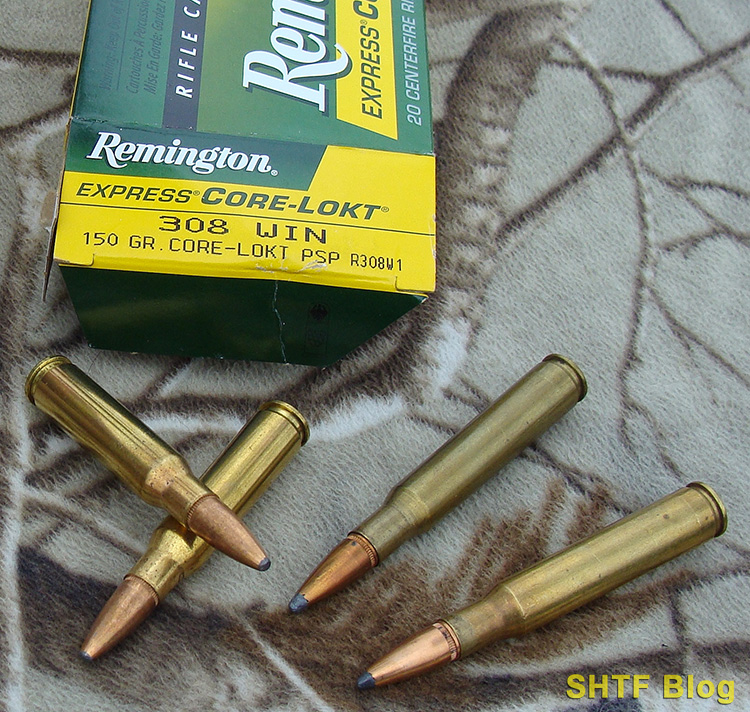
Hornady Interlocks
We’ve probably shot as many deer with .30-caliber Hornady InterLocks as we have with Remington Core-Lokts, the main difference being they were handloads. The bullet, another cup & core type, is Hornady’s 150-grain .30-caliber Spire Point (#3031). It’s proven accurate in a number of .308 and .30/06 bolt-actions.
Also, to date, every deer taken with this bullet has been accompanied by an easy recovery. I’ve read that Interlocks works best if velocity doesn’t exceed 3000 fps, which mirrors our experience (making it a good match for the above calibers). We’ll often see some core and jacket separation but, by the time that occurs, the bullet has already done its job. For those who don’t handload, Hornady offers InterLocks in their American Whitetail line.
InterLock® – Hornady Manufacturing, Inc
Three of the four hunters in my circle own Remington Model Seven .350 Remington Magnum bolt-actions. We break ‘em out when hunting near nasty spots like cedar swamps – among the worst for recovery of deer. So far so good using 200-grain InterLock Spire Points (#3510) handloaded to 2665 fps.
This bullet isn’t as tough as most premium types, but it makes up that in size. I aim for the shoulder, which usually anchors a deer on the spot – although there’s still no guarantee. Same story for the 200-grain TSX version. In that case, a bigger exit makes for easier and shorter tracking.
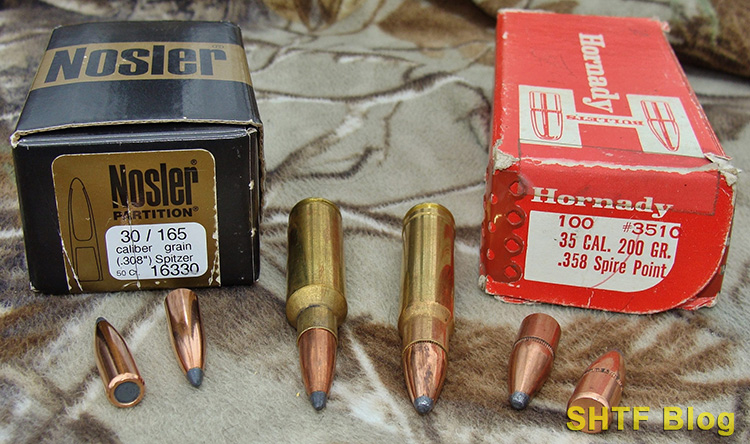
Buying Ammo for Deer Online
You can always check with your local gun store for a box of good deer ammo, but in today’s ammunition market, it’s always hit or miss. Here are some online retailers known for stocking ammo:
- Brownell’s
- Bulk Munitions
- Lucky Gunner
- Natchez (use the Rakuten extension for additional savings at Natchez)
- Optics Planet
- Palmetto State Armory
- Sportsman’s Guide
- Sportsman’s Warehouse
Whitetail Notes
The frame of reference here is whitetails which vary in size by region. Across the land though, most trophy bucks are scored by measuring their antlers. Here in Maine, things are different because our deer are made out of meat. Most of us are more interested in body-weight.
Shoot a buck scaling 200 pounds or more, field-dressed, and beside a year’s supply of meat, you’ll qualify for the Maine Big Buck Club. The live weight of a 200-pounder could approach 250 pounds – a fairly large animal for a smaller caliber. I’m betting some western hunters will be laughing at these figures because mule deer are often larger.
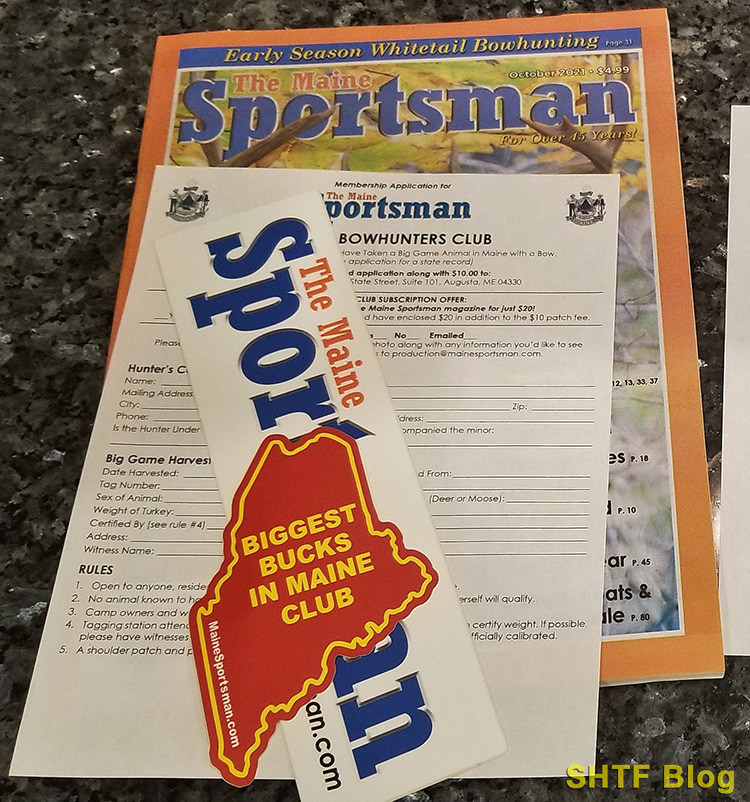
Anyhow, the largest whitetail taken by our crew scaled 232, dressed. My son’s 2021 archery buck weighed 222 pounds. I was into antler-inches for a while (with some success), but now I’m into the culinary aspect. That makes life simpler since the average buck in our neck of the woods probably weighs no more than 150 pounds – plenty good for dining purposes.
Still, a monster buck could show up at any time. Thus, the tried-and-true calibers offer more leeway regarding bullets. That’s why many of our hunters tote .270s, .30/06s, .308s (or even .30/30s); loaded with basic soft-points sold in red or green boxes. Those lucky enough to draw a moose tag will often use the same box of cartridges and return with a pickup-load of meat.
Last Thoughts
The real key to success is the right bullet, not its cost. Whitetails may not be the toughest game animals, but they can still soak up enough lead to cover ground. The SMK in the opener? It’s a great bullet for use in matches! But, on game, it has more in common with a non-expanding FMJ – an inhumane choice for deer.
No worries though. The loads appearing above are but a few of many other great choices. Many successful hunters have differing lists of favorites well-grounded in positive experiences. These work well for us, however, like many other eastern whitetail hunters, most of our action is in the woods, usually within 100 yards.
This explains the absence of long-range VLD bullets in flat-shooting calibers. Others will embrace them for valid reasons often related to the terrain. For what it’s worth though, most of the old standbys like an ’06 can will easily cover 300 yards – still quite a poke for most of us.
